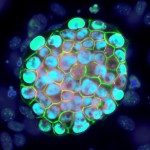Lien vers Pubmed [PMID] – 25048459
PLoS ONE 2014;9(7):e102700
Cystinuria is an autosomal recessive disease caused by the mutation of either SLC3A1 gene encoding for rBAT (type A cystinuria) or SLC7A9 gene encoding for b0,+AT (type B cystinuria). Here, we evidenced in a commonly used congenic 129S2/SvPasCrl mouse substrain a dramatically high frequency of kidney stones that were similar to those of patients with cystinuria. Most of 129S2/SvPasCrl exhibited pathognomonic cystine crystals in urine and an aminoaciduria profile similar to that of patients with cystinuria. In addition, we observed a heterogeneous inflammatory infiltrate and cystine tubular casts in the kidney of cystinuric mice. As compared to another classical mouse strain, C57BL/6J mice, 129S2/SvPasCrl mice had an increased mortality associated with bilateral obstructive hydronephrosis. In 129S2/SvPasCrl mice, the heavy subunit rBAT of the tetrameric transporter of dibasic amino acids was absent in proximal tubules and we identified a single pathogenic mutation in a highly conserved region of the Slc3a1 gene. This novel mouse model mimicking human disease would allow us further pathophysiological studies and may be useful to analyse the crystal/tissue interactions in cystinuria.

